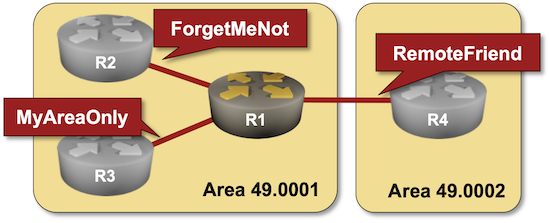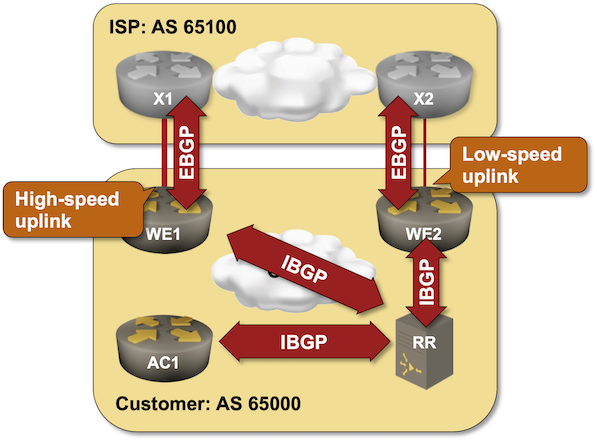netlab: Applying Simple Configuration Changes
For years, netlab has had custom configuration templates that can be used to deploy custom configurations onto lab devices. The custom configuration templates can be Jinja2 templates, and you can create different templates (for the same functionality) for different platforms. However, using that functionality if you need an extra command or two makes approximately as much sense as using a Kubernetes cluster to deploy a BusyBox container.
netlab release 25.09 solves that problem with the files plugin and the inline config functionality.
EVPN Designs: Multi-Pod Fabrics
In the EVPN Designs: Layer-3 Inter-AS Option A, I described the simplest multi-site design in which the WAN edge routers exchange IP routes in individual VRFs, resulting in two isolated layer-2 fabrics connected with a layer-3 link.
Today, let’s explore a design that will excite the True Believers in end-to-end layer-2 networks: two EVPN fabrics connected with an EBGP session to form a unified, larger EVPN fabric. We’ll use the same “physical” topology as the previous example; the only modification is that the WA-WB link is now part of the underlay IP network.
Changing the Layout of netlab Topology Graphs
After I published the updated netlab topology graphs article, Samuel K. Lam quickly made a comment along the lines of now we know how the graph representing the following topology was made, adding a nice ASCII art that illustrated the point I was trying to make much better than my graphs:

ASCII art representing the BGP leak lab
Let’s see how close we can get to that ideal topology diagram with GraphViz and D2 graphs.
Android Phones Might Ask for /64 Delegated Prefix
I’m too old to be fighting with windmills, but sometimes I have to get a rant off my chest. This one was triggered by the latest episode of the hilarious1 “DHCPv6 on Android” soap opera
In a 720-degree turnaround, Android 11 supports DHCPv6, but only for prefix delegation purposes. Yes, you got it right, in a year or two, every phone might want to have a dedicated /64 prefix assigned to it on WiFi segments2.
Want more details? Well, there’s a high-level overview published on the Android Developers blog and a corresponding message sent to the v6ops mailing list. Let’s see how much sense that makes.
Lab: Protect IS-IS Routing Data with MD5 Authentication
Like OSPF and BGP, IS-IS contains a simple mechanism to authenticate routing traffic – IS-IS packets can include a cleartext password or an MD5- or SHA hash. Unlike OSPF, IS-IS can also authenticate:
- The hello packets exchanged between routers
- The contents of Link State PDUs flooded across an area or a domain.
Want to know more? Check out the Protect IS-IS Routing Data with MD5 Authentication lab exercise.

Click here to start the lab in your browser using GitHub Codespaces (or set up your own lab infrastructure). After starting the lab environment, change the directory to feature/3-md5 and execute netlab up.
Public Videos: Ansible for Networking Engineers

I made most of the Ansible for Networking Engineers webinar public; you can watch those videos without an ipSpace.net account.
Want to spend more time watching free ipSpace.net videos? The complete list is here.
Start a Lab From a GitHub netlab Topology File
Someone approached me after my NOG.HR netlab presentation and said: “wouldn’t it be great if we could just start the lab from an example topology published on GitHub?”
It took me almost a year to get it done, but the functionality finally made it into the 25.09 release:
SwiNOG 40: Deploying Precision Time Protocol across WAN
Is it possible to deploy Precision Time Protocol across a country-wide WAN network and reach nanosecond-level synchronization between cities? It’s definitely not trivial and only works over dedicated infrastructure; for more details, watch the PTP in WANs (video) presentation Oliver Ettlin had at SwiNOG 40.
Changing Colors and Line Styles in netlab Graphs
Last week, I explained how to generate network topology graphs (using GraphViz or D2 graphing engines) from a netlab lab topology. Let’s see how we can make them look nicer (or at least more informative). We’ll work with a simple leaf-and-spine topology with four nodes1:
defaults.device: frr
provider: clab
nodes: [ s1, s2, l1, l2 ]
links: [ s1-l1, s1-l2, s2-l1, s2-l2 ]
This is the graph generated by netlab create followed by dot graph.dot -T png -o graph.png:
Pleasant Surprise: Google AI Overview
When I was writing a blog post, I needed a link to the netlab lab topology documentation, so I searched for “netlab lab topology” (I know I’m lazy, but it felt quicker than navigating the sidebar menu).
The AI overview I got was way too verbose, but it nailed the Key Concepts and How It Works well enough that I could just use them in the netlab README.md file. Maybe this AI thing is becoming useful after all ;)
Use Additional BGP Paths for IBGP Load Balancing
I wrote about the optimal BGP path selection with BGP additional paths in 2021, and I probably mentioned (in one of the 360 BGP-related blog posts) that you need it to implement IBGP load balancing in networks using BGP route reflectors. If you want to try that out, check out the IBGP Load Balancing with BGP Additional Paths lab exercise.

Click here to start the lab in your browser using GitHub Codespaces (or set up your own lab infrastructure). After starting the lab environment, change the directory to lb/4-ibgp-add-path and execute netlab up.
Arista EOS Hates a Routing Instance with No Interfaces
I always ask engineers reporting a netlab bug to provide a minimal lab topology that would reproduce the error, sometimes resulting in “interesting” side effects. For example, I was trying to debug a BGP-related Arista EOS issue using a netlab topology similar to this one:
defaults.device: eos
module: [ bgp ]
nodes:
a: { bgp.as: 65000 }
b: { bgp.as: 65001 }
Imagine my astonishment when the two switches failed to configure BGP. Here’s the error message I got when running the netlab’s deploy device configurations Ansible playbook:
SwiNOG 40: When a Routing Control Functions Is Too Fresh
During integration testing, I find unexpected quirks in network devices way too often. However, that’s infinitely better than experiencing them in production (even after thoroughly testing stuff) while discovering that your peers don’t care about routing security, RPKI, and similar useless stuff.
For example, what happens if you define a new Routing Control Function (RFC) on Arista EOS and apply it to BGP routing updates in the same configuration session? You’ll find out in the Sorry We Messed Up (video) presentation Stefan Funke had at SwiNOG 40 (note: the bug has been fixed in the meantime).
Updated: netlab Network Topology Graphs
netlab release 25.09 introduced numerous graphing enhancements and a new graph type (IS-IS graphs), so I decided to write a series of blog posts explaining how you can generate graphs from netlab lab topologies.
I wrote an intro to netlab topology graphs years ago, and as expected, it was hopelessly outdated, so I started the project with a complete overhaul of that article.
[FATAL] Ansible Release 12.0 Breaks netlab Jinja2 Templates
On September 9th, the ansible release 12.0 appeared on PyPi. It requires ansible-core release 2.19, which includes breaking changes to Jinja2 templating. netlab Jinja2 templates rely on a few Ansible Jinja2 filters; netlab thus imports and uses those filters, and it looks like those imports pulled in the breaking changes that consequently broke the netlab containerlab configuration file template (details).
netlab did not check the Ansible core version (we never had a similar problem in the past), and the installation scripts did not pin the Ansible version (feel free to blame me for this one), which means that any new netlab installation created after September 9th crashed miserably on the simplest lab topologies.
This is the workaround we implemented in netlab release 25.09-post1 (released earlier today):
Lab: Running IS-IS over IPv4 Unnumbered and IPv6 LLA Interfaces
IS-IS does not use IPv4 or IPv6, so it should be a no-brainer to run it over IPv4 unnumbered or IPv6 LLA interfaces. The latter is true; the former is smack in the middle of the It Depends™ territory.
Want to know more or test the devices you’re usually working with? The Running IS-IS Over Unnumbered/LLA-only Interfaces lab exercise is just what you need.

Click here to start the lab in your browser using GitHub Codespaces (or set up your own lab infrastructure). After starting the lab environment, change the directory to basic/7-unnumbered and execute netlab up.
The Curious Case of ‘ip host’ Configuration Command
Since time immemorial, I have used the ip host router configuration command to get host-to-IP mappings in networking labs without going through the hassle of setting up a DNS server. Some devices even accepted multiple IP addresses in the ip host command, allowing you to list all router interfaces in a single command and get reverse (IP-to-host) mapping working like a charm. Or so I thought 🤦♂️
It turns out I’m too old, and what I know is sometimes no longer true. It seems that the last implementation working as I expected is Cisco IOS Classic ☹️
Labbing Network Technology Details with netlab
It’s been over four years since I published the last Software Gone Wild episode. In the meantime, I spent most of my time developing an open-source labbing tool, so it should be no surprise that the first post-hiatus episode focused on a netlab use case: how Ethan Banks (of the PacketPushers fame) is using the tool to quickly check the technology details for his N is for Networking podcast.
As expected, our discussion took us all over the place, including (according to Riverside AI):
SwiNOG 40: Reliability of High-Speed Transceivers
Whenever you see Gerhard Stein and Thomas Weible from Flexoptix in a list of presenters, three things immediately become obvious:
- It will be about transceivers
- It will be fun
- It will include some crazy stuff
Their SwiNOG 40 presentation (video) met all three expectation. We learned how well transceivers cope with high temperatures and what happens when you try to melt them with a heat gun.
netlab 25.09: IPv6 RA, Link Impairments, and Performance Gains
netlab release 25.09 includes:
- Link impairment (implemented with Linux netem queuing discipline) defined in lab topology or configured/controlled with the netlab tc command
- Configurable IPv6 Router Advertisement parameters
- The files plugin to store the content of short files (including custom configuration templates) directly in the lab topology
- Support for Nokia SR-OS container (SR-SIM)
- Support for very large topologies (tested so far: approximately 3000 lab devices)
But wait, there’s more (as always):